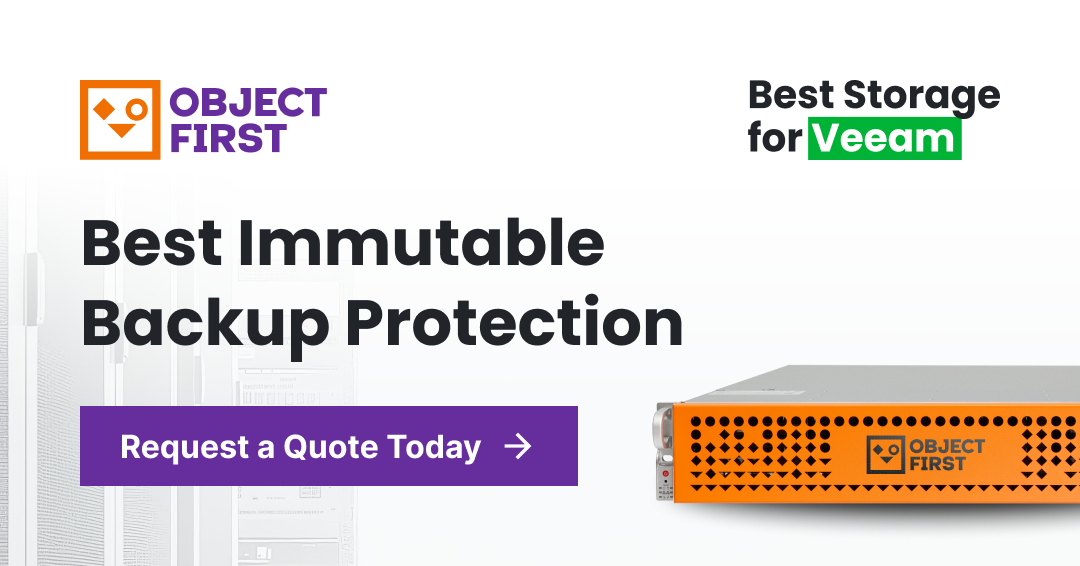What is Data Immutability? A Complete Guide
An accounting firm with just thirty employees thought it was too small to be an attractive target. But one suspicious email was all it took: within hours, ransomware had encrypted every client file, financial record, and data backup.
The moral of the story? Size doesn't matter to cybercriminals anymore. Hackers target opportunity, not scale—and the most devastating damage often falls on companies least prepared to defend themselves.
The good news is that organizations of all sizes can regain control with data immutability, a last-line defense that attackers can't touch. Here's what it is, how it works, and why it's paramount for staying resilient.
What Is Data Immutability?
Data immutability is the concept that once data is written, it cannot be changed, deleted, or tampered with. There are no edits or overwrites, meaning what’s stored stays exactly as it was written. This makes it one of the most powerful tools for protecting information against threats like ransomware, accidental deletion, or internal threats.
Today, immutable data is indispensable for secure backups, regulatory compliance, and building true cyber resilience. It guarantees that backup copies remain clean, uncompromised, and ready to restore, no matter what happens. If a ransomware attack hits, an immutable backup ensures you always have an untouched version to fall back on.
How Does Data Immutability Work?
Data immutability works by locking information in place the moment it’s created. Instead of allowing edits or overwrites, any updates or changes must be recorded as entirely new entries, leaving the original untouched.
Immutability in data backup is made possible through technologies like WORM (Write Once, Read Many) storage and S3 Object Lock. Once a backup is written to an immutable system, it cannot be modified or deleted during the retention period defined by the backup creator.
Implementing data immutability usually follows these key steps:
Data is written once to a storage system configured with immutability controls, such as Object Lock in object storage environments.
Retention policies are set, defining how long the data must remain unchanged.
Access controls guarantee that users (even administrators) cannot modify or delete the protected data before the retention period expires.
Versioning tracks every change. Instead of editing the original file, new versions are created, preserving a clear, auditable trail.
Verification mechanisms like hash checks or cryptographic signatures ensure the data remains as it was originally stored.
Who Needs Data Immutability?
According to Veeam's Data Protection Trends Report, 96% of ransomware attacks specifically target backup data—the very thing businesses count on for recovery.¹
Whether you're running a small local business, a mid-sized company, or a multinational enterprise, the stakes are the same. If your data is vulnerable, your operations, reputation, and revenue are all at risk. Data immutability ensures that when a cyberattack strikes, you have a clean, unalterable backup to restore from—your final line of defense when everything else fails.
That's why immutability isn't just a buzzword, but the foundation of business continuity. No matter the size, every organization needs immutable backups they can trust when it matters most.
The Benefits of Data Immutability
Keeps Clean Backups Ready for Rapid Recovery
Because immutable backups can't be altered or deleted, you can trust that your recovery point is safe and fully intact. Instead of scrambling to rebuild systems or paying a ransom, you can restore operations quickly and confidently, turning a potential disaster into a manageable setback.
Neutralizes Insider Risks Before They Spread
Internal risks—whether accidental or malicious—are just as dangerous as cyberattacks. Even if a privileged user or administrator makes a mistake (or worse, acts intentionally), immutable storage preserves the original data integrity, creating a critical safety layer from the inside out.
Strengthens Regulatory Compliance and Audit Readiness
Many industries require strict data integrity under HIPAA, GDPR, or NIS2 regulations. With an immutable architecture, businesses can demonstrate that information is adequately protected, reducing legal exposure and strengthening trust with regulators, partners, and customers.
Reduces Recovery Time and Operational Disruption
With a secure, verified backup ready to deploy, your IT team can drastically reduce Recovery Time Objectives (RTOs). Instead of spending days assessing the damage, re-verifying backups, or reconstructing lost data, they can restore operations quickly, avoiding costly downtime.
Creates Transparent, Auditable Data Histories
Immutability introduces built-in versioning and traceability. Every update is recorded as a new version rather than overwriting existing data. It provides a complete, transparent data history—making it easy to track changes, investigate incidents, and prove data authenticity when needed.
Mutable vs. Immutable Data
The difference between mutable and immutable data is straightforward. One gives attackers a chance to destroy your ransomware response plan, while the other provides a clean copy to recover from.
Below is a clear breakdown of how these two data models compare:
| Mutable Data | Immutable Data | |
|---|---|---|
| Editability | Can be changed, overwritten, or deleted at any time | Cannot be altered or deleted during the retention period |
| Security Risk | Highly vulnerable to ransomware, human error, and insider threats | Resistant to tampering, encryption, or accidental deletion |
| Data Integrity | Original state can be lost or manipulated | Original version is preserved exactly as written |
| Auditability | Limited traceability of changes | Full version history ensures transparency and accountability |
| Backup Reliability | Risk of corrupted or compromised backups | Guarantees a clean, untouched recovery point |
| Compliance Readiness | May fail to meet strict regulatory requirements | Aligned with standards like GDPR, HIPAA, NIS2, and others |
| Use Case Suitability | Acceptable for temporary or low-risk data | Essential for sensitive, critical, or regulated data |
| Recovery Confidence | Uncertainty about data reliability post-attack | Peace of mind knowing backups can’t be tampered with |
Immutability for Everyone Starts with Ootbi
Ransomware attacks are more sophisticated than ever, with 69% of companies experiencing at least one incident leading to data encryption or exfiltration.²
At Object First, we believe no business should ever have to pay a ransom to recover its data. That's why we created Ootbi (Out-of-the-Box Immutability), which delivers secure, simple, and powerful on-premises backup storage for Veeam customers.
With our latest hardware and software updates, new Ootbi appliances are now available for organizations of all sizes. From 20 to 432 TB per node, you can mix, match and scale existing clusters to get up to 1.7 PB capacity per cluster and meet your immutable storage needs.
Whether you're a small company or a large enterprise, don't wait until a disaster happens! Attend a 30-minute Ootbi demo and learn to protect your backups.
Resources
Ransomware Encryption: Prevention and Response
Veeam Report Finds Close to 70% of Organizations Still Under Cyber-Attack Despite Improved Defenses


